In my May column I proposed a few examples to show how to facilitate certain finger combinations, using the various fingerings at our disposal. It was mostly about Bb in all ranges of the flute.
For instance, one of the most difficult orchestral excerpts I have ever played does not appear on the audition lists. It is the opening five bars of Beethoven’s Fourth Symphony where the flute plays a Bb above the staff pp in unison with two clarinets, two bassoons and two horns for what feels like forever.
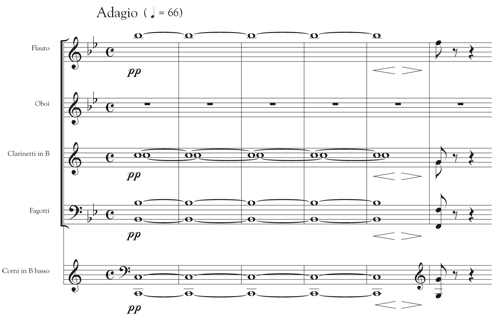
The score calls for one flute only so there no help possible from a second flute. I occasionally used the harmonic produced by the low Eb fingering overblown at the third partial for a faint pp color like the interminable Bb at the onset of this beautiful Symphony #4 by Beethoven.
Old orchestra players know that in a slow movement, the greater the conductor – the slower the beat. This example is marked at 66 by Beethoven (Toscanini: 40-46, Bruno Walter: 54-58, George Szell: 49-44) so be prepared to control breath and pitch.
For this, I would use the low Eb fingering with the left middle finger (A) up. It’s a little sharp (a blessing in itself to match the other winds) and comes out very soft, which allows you to save your air and hopefully not breathe. For some flutists this is one of those bad fingerings, but once you have tried it, you may change your mind.
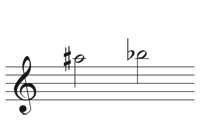
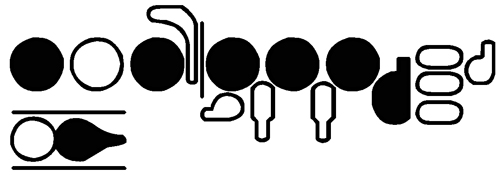
The last note in the Lux aeterna of Verdi’s Requiem is also a Bb, the highest one (pp), to be reached dolcissimo after a problematic diminuendo.
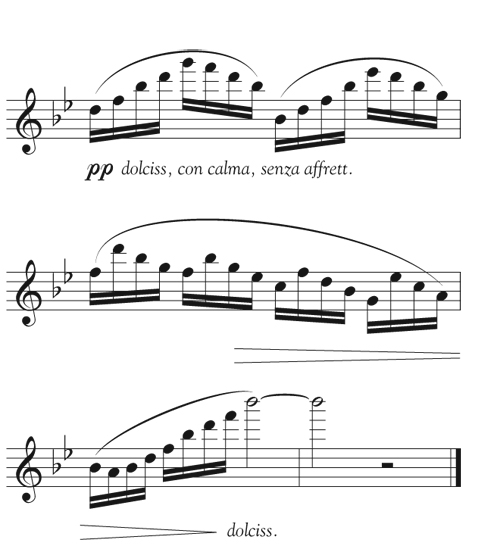
With the real fingering, this Bb tends to be a bit flat and resistant to soft playing. Try fingering it this way:
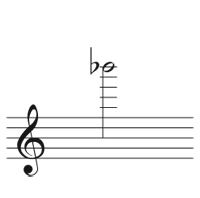
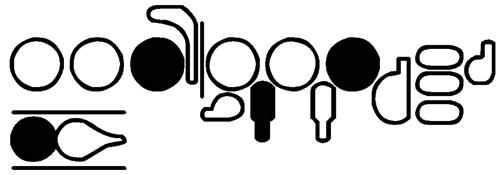
Left Hand: Thumb Bb – G
Right Hand: 1st trill key – D (Right ring finger) – pinkie off.
The connection between high F and high Bb is a little tricky, but the highest note is sweet and angelic which is a blessing.
This fingering also comes in handy for other examples of a high-flying A# or Bb, such as the last chord of Richard Strauss’ tone poem Ein Heldenleben (A Hero’s Life). It has a perfect Eb major chord that is pp, and diminuendo, with the whole flute section (three flutes and piccolo) hovering one octave above everybody else
I am not alone in this quest for alternate fingerings. Robert Cole, of the Philadelphia Orchestra, studied with William Kincaid and became a member of that legendary flute section. Cole wrote, “Seated down the line from him [William Kincaid], I would hear him changing the sound of a repeated note, and I would see that he did this sometimes by changing the fingerings for a very subtle, but interesting, difference in color.” Piccolo players also have their own secrets to find the correct intonation together with the right dynamic. The best players are sought by orchestras and conductors for their control of pitch and dynamics, matters that are not found in excerpt books.
Many people would call easy solutions to fingerings cheating. I, on the contrary, am not an advocate of the “no pain, no gain” philosophy.
Besides the simplifications afforded by fingering notes differently, I was not ashamed to use them as visual and aural metaphors. “L’œil écoute,” (The eye listens) says a poet. The impressionists gave us “symphonies of colors,” while modern action painting or abstract expressionism are “cacophonies of dissonances”.
Instead of the universal and international big tone sought by players and flute makers, tone qualifies with (your choice) dark, light, pale, transparent, cloudy, stormy, somber, iridescent, shining, dull, gray, etc.
With a little imagination we could think of the flute as a painter’s palette, that funny piece of wood with a hole for the thumb where the artist lays down his choice of pigments, squeezing the tubes of pure color oils to be spread with knives, giving life to the ancient gouache or the modern acrylic, caressing the tender watercolors with a soft animal-fur brush from the palettes (same word). The pigments’ names are already poetic in themselves, and almost music: pastel, vermilion, indigo, ultramarine, scarlet, crimson, emerald, etc.
When we were learning to play the flute, we were told to use only one fingering for each note, the real fingering. Bb was played, always, with the right hand forefinger. Middle C# was always played without fingers. F# in all registers was produced by the right hand ring finger. Middle D and Eb were unacceptable if the first key was down, and so on.
Basic fingerings had to become automatic. Soon they became second nature. You played them without thinking, without even wondering if there was another possibility. Monsieur Crunelle (my professor at the Conservatoire) used to say that you should read the notes and play without any mental process between the little black signs and the hands.
As our playing improved, basic fingerings remained the norm. Then practice and experience led to discoveries. New ways to play things again gave spice to practice.
String players use different positions. The same note played on the D string has a different color on the G string; a passage in the third position can be played on the first with interesting results. The up-bow gesture does not have the same power as the down-bow. Bowing near the bridge can create a harsh sound, whereas the caress of the bow over the fingerboard is more feathery. By the way, this soft quality is called flautando i.e. emulating the flute.
Different fingerings on the flute produce slightly different sounds. Sometimes they help facility, or they tune better with other instruments, or they change the note’s color for a more evocative character.
Aside from this long digression, my purpose here is to look at fingerings that enhance or color the sound. By enhance, I mean that they sometimes make the tone bigger and more focused, other times more veiled and fragile. Some of them affect the pitch, obviously, and can be used for tuning purposes. They are not always applicable, especially in a fast tempo or when they contrast too much with neighboring notes.
For simplicity purposes, the diagram shows only keys activated by one finger.
Note: A black key indicates a finger down, whether it closes or opens a key.
For more focus and stability in the low register, time permitting, all notes from low G to low C (or B), put the left pinky on the tube, under the G# lever, as a silent (or dead) key.
Low G, F#, F, E, D#, D, C#, C (B, when present): examples:
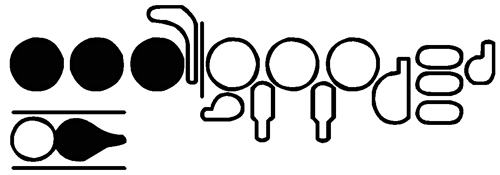
To
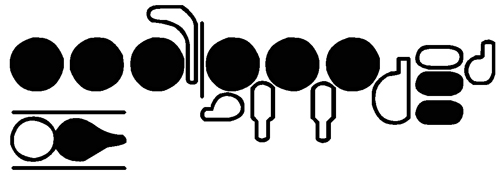
Middle C : p , pp , faint
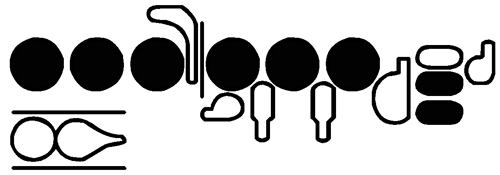
Middle C#: p, pp, faint
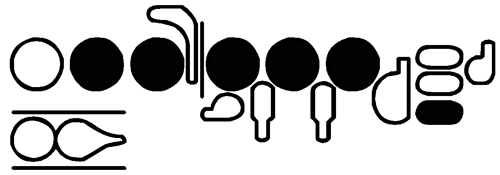
Middle B: p, pp, faint
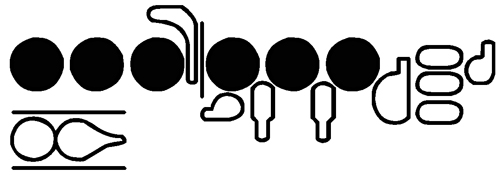
A above staff: resonant, more focused
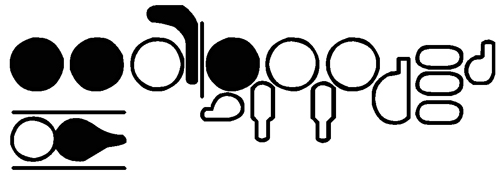
C above staff: p, pp, faint
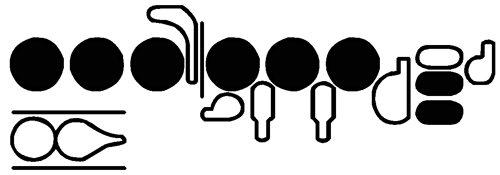
C above staff: p, pp, sharp
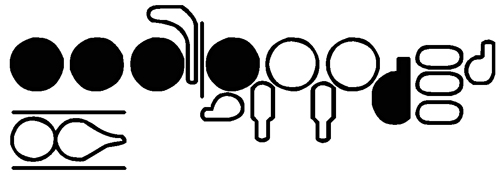
Db/C# above staff: p, pp, sharp, stable
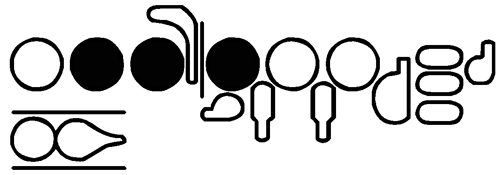
D above staff: p, pp, sharp, stable
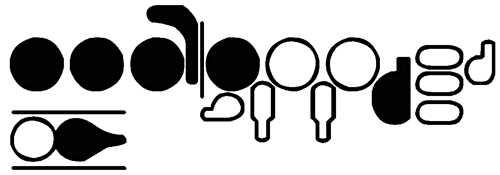
Inquisitive flutists should experiment with these quirky fingerings. With time and an open ear the flutist may come to view these suggestions as normal options rather than as wrong or abnormal fingerings.
Finally, try this useful fingering for Middle E which is very focused and crack-proof. The problem here is an awkward need for the right pinky to activate three keys simultaneously.
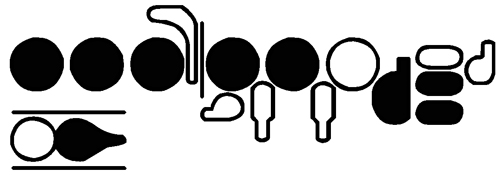
For some acoustical reason, this E fingering cracks less than the real E, and it is more focused. If and when there is time to place it, it is a safeguard against the breaking of this notoriously explosive and perilous note. A famous example to try it on is the Es that start three out of the four movements of the Bach Partita: Allemande, Corrente, and Bourrée Anglaise.
Home > Tuning and Coloring Tone with Different Fingerings
Tuning and Coloring Tone with Different Fingerings
SHARE THIS ARTICLE
In my May column I proposed a few examples to show how to facilitate certain finger combinations, using the various fingerings at our disposal. It was mostly about Bb in all ranges of the flute.
For instance, one of the most difficult orchestral excerpts I have ever played does not appear on the audition lists. It is the opening five bars of Beethoven’s Fourth Symphony where the flute plays a Bb above the staff pp in unison with two clarinets, two bassoons and two horns for what feels like forever.
The score calls for one flute only so there no help possible from a second flute. I occasionally used the harmonic produced by the low Eb fingering overblown at the third partial for a faint pp color like the interminable Bb at the onset of this beautiful Symphony #4 by Beethoven.
Old orchestra players know that in a slow movement, the greater the conductor – the slower the beat. This example is marked at 66 by Beethoven (Toscanini: 40-46, Bruno Walter: 54-58, George Szell: 49-44) so be prepared to control breath and pitch.
For this, I would use the low Eb fingering with the left middle finger (A) up. It’s a little sharp (a blessing in itself to match the other winds) and comes out very soft, which allows you to save your air and hopefully not breathe. For some flutists this is one of those bad fingerings, but once you have tried it, you may change your mind.
The last note in the Lux aeterna of Verdi’s Requiem is also a Bb, the highest one (pp), to be reached dolcissimo after a problematic diminuendo.
With the real fingering, this Bb tends to be a bit flat and resistant to soft playing. Try fingering it this way:
Left Hand: Thumb Bb – G
Right Hand: 1st trill key – D (Right ring finger) – pinkie off.
The connection between high F and high Bb is a little tricky, but the highest note is sweet and angelic which is a blessing.
This fingering also comes in handy for other examples of a high-flying A# or Bb, such as the last chord of Richard Strauss’ tone poem Ein Heldenleben (A Hero’s Life). It has a perfect Eb major chord that is pp, and diminuendo, with the whole flute section (three flutes and piccolo) hovering one octave above everybody else
I am not alone in this quest for alternate fingerings. Robert Cole, of the Philadelphia Orchestra, studied with William Kincaid and became a member of that legendary flute section. Cole wrote, “Seated down the line from him [William Kincaid], I would hear him changing the sound of a repeated note, and I would see that he did this sometimes by changing the fingerings for a very subtle, but interesting, difference in color.” Piccolo players also have their own secrets to find the correct intonation together with the right dynamic. The best players are sought by orchestras and conductors for their control of pitch and dynamics, matters that are not found in excerpt books.
Many people would call easy solutions to fingerings cheating. I, on the contrary, am not an advocate of the “no pain, no gain” philosophy.
Besides the simplifications afforded by fingering notes differently, I was not ashamed to use them as visual and aural metaphors. “L’œil écoute,” (The eye listens) says a poet. The impressionists gave us “symphonies of colors,” while modern action painting or abstract expressionism are “cacophonies of dissonances”.
Instead of the universal and international big tone sought by players and flute makers, tone qualifies with (your choice) dark, light, pale, transparent, cloudy, stormy, somber, iridescent, shining, dull, gray, etc.
With a little imagination we could think of the flute as a painter’s palette, that funny piece of wood with a hole for the thumb where the artist lays down his choice of pigments, squeezing the tubes of pure color oils to be spread with knives, giving life to the ancient gouache or the modern acrylic, caressing the tender watercolors with a soft animal-fur brush from the palettes (same word). The pigments’ names are already poetic in themselves, and almost music: pastel, vermilion, indigo, ultramarine, scarlet, crimson, emerald, etc.
When we were learning to play the flute, we were told to use only one fingering for each note, the real fingering. Bb was played, always, with the right hand forefinger. Middle C# was always played without fingers. F# in all registers was produced by the right hand ring finger. Middle D and Eb were unacceptable if the first key was down, and so on.
Basic fingerings had to become automatic. Soon they became second nature. You played them without thinking, without even wondering if there was another possibility. Monsieur Crunelle (my professor at the Conservatoire) used to say that you should read the notes and play without any mental process between the little black signs and the hands.
As our playing improved, basic fingerings remained the norm. Then practice and experience led to discoveries. New ways to play things again gave spice to practice.
String players use different positions. The same note played on the D string has a different color on the G string; a passage in the third position can be played on the first with interesting results. The up-bow gesture does not have the same power as the down-bow. Bowing near the bridge can create a harsh sound, whereas the caress of the bow over the fingerboard is more feathery. By the way, this soft quality is called flautando i.e. emulating the flute.
Different fingerings on the flute produce slightly different sounds. Sometimes they help facility, or they tune better with other instruments, or they change the note’s color for a more evocative character.
Aside from this long digression, my purpose here is to look at fingerings that enhance or color the sound. By enhance, I mean that they sometimes make the tone bigger and more focused, other times more veiled and fragile. Some of them affect the pitch, obviously, and can be used for tuning purposes. They are not always applicable, especially in a fast tempo or when they contrast too much with neighboring notes.
For simplicity purposes, the diagram shows only keys activated by one finger.
Note: A black key indicates a finger down, whether it closes or opens a key.
For more focus and stability in the low register, time permitting, all notes from low G to low C (or B), put the left pinky on the tube, under the G# lever, as a silent (or dead) key.
Low G, F#, F, E, D#, D, C#, C (B, when present): examples:

To
Middle C : p , pp , faint

Middle C#: p, pp, faint
Middle B: p, pp, faint

A above staff: resonant, more focused

C above staff: p, pp, faint

C above staff: p, pp, sharp
Db/C# above staff: p, pp, sharp, stable

D above staff: p, pp, sharp, stable
Inquisitive flutists should experiment with these quirky fingerings. With time and an open ear the flutist may come to view these suggestions as normal options rather than as wrong or abnormal fingerings.
Finally, try this useful fingering for Middle E which is very focused and crack-proof. The problem here is an awkward need for the right pinky to activate three keys simultaneously.
For some acoustical reason, this E fingering cracks less than the real E, and it is more focused. If and when there is time to place it, it is a safeguard against the breaking of this notoriously explosive and perilous note. A famous example to try it on is the Es that start three out of the four movements of the Bach Partita: Allemande, Corrente, and Bourrée Anglaise.
ABOUT THE AUTHOR
Michel Debost
Michel Debost is the former principal flutist of the Orchestre de Paris and flute professor at the Paris Conservatory and Oberlin Conservatory. He is the author of The Simple Flute.
MORE FROM THIS ISSUE
A Conversation with Linda Pulley
Five Tips for Guiding Student Arrangers
ADVERTISEMENT
Order your Marching and Color Guard Awards this Fall!
Orders may be placed through the online store, by email (awards@theinstrumentalist.com) or by calling 888-446-6888.